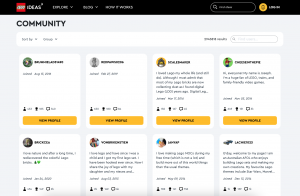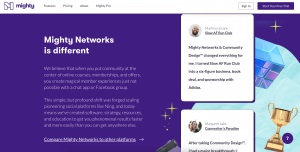Not Every Company Can Build An Online Community.

I’m a member of various online communities of brands that speak to me. What I’ve realized is companies have had varying degrees of success in building an online community. Some companies have been extremely successful and have built thriving, engaged communities that have had a positive impact on their business.
The successful ones exhibit common characteristics.
Common Traits Of An Online Community
Active Participation
Successful communities have high levels of engagement, with members actively participating in discussions, sharing content, and helping one another. This level of involvement indicates a strong and vibrant community.
It’s not about the number of members or followers, it’s about the depth of engagement with your online community members.
Build on the sense of belonging
Successful communities foster a sense of belonging and community among their members. Members feel connected to the brand or the cause that the community represents and identify themselves as part of the community.
Content speaks to one and all
A successful online community often generates a significant amount of user-generated content. This includes discussions, testimonials, product reviews, and other forms of content created by community members, showcasing their involvement and investment in the community.
Supportive Ecosystem
Successful communities provide a supportive environment where members can seek advice, share experiences, and receive help. Members feel comfortable and safe sharing their thoughts and opinions within the community.
Continuous Value Creation
Successful communities provide value to their members by offering exclusive content, educational resources, networking opportunities, discounts, or other benefits. This value proposition encourages members to actively participate and remain engaged.
Co-creation
Online communities provide a platform for co-creation and collaboration between the company and its customers. By involving community members in product development, testing, and ideation processes, companies can foster innovation and create products or services that better meet the needs of their customers. This collaborative approach can contribute to the long-term success and growth of a company.
Grooming members to be Brand Advocates
A successful online community often results in members becoming brand advocates. They develop a strong affinity for the brand and willingly promote it to others, leading to increased brand awareness and customer acquisition.
However, it’s important to note that building a successful online community requires time, effort, and a deep understanding of the target audience. Not all attempts to build communities will be equally successful, and some communities may struggle to gain traction or maintain engagement. It’s crucial for companies to continually evaluate and adapt their strategies to meet the evolving needs and expectations of community members.
Companies have returned from extinction with the support of their communities. Harley Davidson was heading towards irrelevance before they realized the merit in the brotherhood of bikers ‘HOG’, so they built a community to support these bikers who are loyal members of this one big motorcycle club.

Online Community of Harley Davidson Motorcycle Owners
In the early 2000s, LEGO faced financial difficulties and declining sales. However, the company turned to its passionate online fan community for support. LEGO actively engaged with the community sought feedback, and even invited fans to contribute ideas and designs. This collaboration led to the development of new products and a renewed focus on customer preferences. The involvement of the online community played a significant role in LEGO’s successful turnaround, and the company regained its position as a leading toy brand.

Online Community of Lego Lovers
MakerBot, a manufacturer of 3D printers, faced challenges in 2014 due to quality issues with their products. However, the company actively engaged with its online community of users, known as the “MakerBot Operators.” MakerBot encouraged feedback, listened to customer concerns, and made improvements based on community input. This collaborative approach helped restore confidence in the brand, leading to a resurgence in sales and re-establishing MakerBot’s position in the 3D printing market.
Old Spice, the iconic men’s grooming brand, launched a highly successful online marketing campaign in 2010. The campaign included humorous and interactive videos that quickly gained popularity on social media platforms. As a result, an online community of fans emerged, with people actively engaging with the brand, sharing content, and participating in discussions. Old Spice capitalized on this momentum by directly responding to customer comments and creating personalized video responses. The campaign significantly revitalized the brand, attracting a younger demographic and boosting sales. The community is called the ‘School of Swagger.’
Why do companies fail?
Globally, online Communities are growing at a CAGR of 13.9%. Despite the realization that these communities are important to them, they fail to integrate with business.
Statistics (as per different industry reports) that suggest the value that online communities add to a business –
👉 90% of the companies interviewed say they use the community members’ suggestions to improve their products & services.
👉 59% of companies use online communities to address customer support.
👉 85% of online businesses, and communities have had a positive impact on business.
Online community building is a business strategy and not a marketing strategy, and the entire company must pivot to support a community.
Creating and sustaining successful online communities can be challenging for companies due to various reasons.
Lack of a large vision
Without a vision and well-defined strategy, companies may struggle to establish a clear purpose, goals, and guidelines for their online communities. This can lead to a lack of direction and inconsistent engagement, making it difficult for the online community to thrive.
Insufficient Resources
Building and managing an online community requires dedicated resources, including personnel, time, and financial investments. If a company fails to allocate sufficient resources, it may not be able to provide the necessary support, moderation, and content creation required for community success.
Ineffective Community Management
Community management plays a crucial role in facilitating engagement and fostering a positive environment. If a company lacks skilled community managers who can effectively moderate discussions, encourage participation, and address conflicts, the community may struggle to thrive.
Lack of Member Engagement
For an online community to flourish, it needs active participation from its members. If a company fails to create compelling content, encourage interactions, and provide value to community members, they may lose interest and engagement may decline.
Failure to Adapt to member needs
Online communities evolve, and it’s essential for companies to continuously adapt to changing member needs and preferences. If a company fails to listen to its community members, address their feedback, and make necessary improvements, the community may become stagnant and lose relevance.
Lack of Authenticity and Trust
Trust is vital in online communities. If a company fails to establish and maintain authenticity, transparency, and trustworthiness, community members may feel disengaged or skeptical, hindering the community’s growth and success.
Inadequate Promotion and Outreach
Companies need to promote their online communities effectively to attract and retain members. If a company fails to invest in marketing efforts, outreach, and creating awareness about the community, it may struggle to gain traction and build a critical mass of engaged participants.
Companies need to recognize these challenges and invest in community-building strategies that address these factors. Building successful online communities requires a long-term commitment, active engagement, and a deep understanding of the target audience’s needs and preferences.
How To Get Started With An Online Community?
Building an online community for a brand requires a strategic approach and dedicated effort.
Remember if you’re building a community, its existence is not to serve the business, but to serve its members.
Define the Purpose
Clearly define the purpose and goals of the online community. Determine what value the community will provide to its members and how it aligns with the brand’s mission and values.
Choose the Right Platform
Select the appropriate platform for your online community, such as social media platforms, forums, or dedicated community platforms. Consider the preferences and demographics of your target audience.
Create Compelling Content
Develop high-quality and relevant content that appeals to your target audience. This can include informative blog posts, engaging videos, podcasts, or interactive elements that encourage participation.
Encourage conversations
Foster interaction among community members by creating opportunities for engagement. This can be achieved through discussions, Q&A sessions, polls, contests, or sharing member-generated content.
Be Responsive and Engage
Actively participate in the community by responding to comments, answering questions, and fostering conversations. Show genuine interest in the community members and their contributions.
Facilitate Connections
Help community members connect by providing networking opportunities and platforms for communication. Encourage collaboration and support among community members.
Provide Exclusive Benefits
Offer exclusive benefits or rewards to community members to encourage participation and foster loyalty. This can include early access to new products, special discounts, or unique experiences.
Promote Offline Events
Organize or support offline events like meetups, workshops, or conferences where community members can gather and engage in person. This helps strengthen community bonds.
Analyze and Iterate
Continuously analyze community metrics and feedback to understand what is working and what can be improved. Adjust strategies and initiatives based on the insights gained.
Build Trust and Authenticity
Maintain transparency, honesty, and authenticity in all interactions with the community. Building trust is crucial for fostering a strong and loyal community.
Brands that have cracked the code
Apple has a large and active online community of users who share tips, tricks, and advice about Apple products. The community is also a great place to get support for Apple products.
Nike has a community of runners who share training tips, race reports, and motivation. The community is a great way to stay motivated and connect with other runners.

The Online Community by NIKE for runners
Lululemon has a community of yoga and fitness enthusiasts who share workout routines, recipes, and fashion tips. The community is a great way to find inspiration and support.
Sephora has a community of beauty enthusiasts who share makeup tips, product reviews, and hair styling advice. The community is a great place to learn about new products and find inspiration for your next look.
Red Bull has a community of athletes and adrenaline junkies who share stories, videos, and photos of their adventures. The community is a great place to find inspiration and motivation.

The Red Bull Online Community
These are just a few names of big brands that thrive because of their communities. Lesser-known brands such as Allbirds, Huel, Thrive Market, and Glossier have been successful as well.
Technology platforms can’t be avoided
There are several software options available to build an online community. The choice of software depends on your specific needs, budget, technical expertise, and the features you require for your community. Here are some popular options-
Discourse is a widely used open-source community platform that offers robust features for discussions, user profiles, moderation tools, and integrations. It can be self-hosted or used through Discourse’s hosting service.

Build your Online community with Discourse software
Vanilla Forums
Vanilla Forums is a flexible and customizable community platform that provides features like discussions, user engagement tools, gamification, and integrations with popular third-party applications.
Lithium
Lithium is a comprehensive community platform that offers features such as forums, social media integration, knowledge bases, and customer support solutions. It focuses on customer engagement and support.
WordPress with BuddyPress
WordPress, combined with the BuddyPress plugin, allows you to create a community within a WordPress website. It offers features like user profiles, activity feeds, groups, and forums.
Salesforce Community Cloud is an enterprise-level solution that enables companies to build branded communities for their customers, partners, or employees. It provides robust collaboration and engagement features.
Facebook Groups
Facebook Groups is a popular option for building online communities due to its ease of use and large user base. It allows you to create public or private groups for discussions, sharing content, and community building.
Mighty Networks
Mighty Networks is a platform that focuses on creating niche communities and offers features such as discussions, events, courses, and monetization options. It aims to facilitate meaningful connections among community members.

Build your Online community with Mighty Networks
Tribe is a community platform that provides tools for discussions, user profiles, Q&A sessions, and content curation. It offers customization options and integrations with other business tools.

Build your Online community with Tribe Social
Slack community
While primarily known as a team collaboration tool, Slack can also be used to build online communities through the creation of public or private channels. It allows real-time messaging, file sharing, and integrations with other apps.

Build your Online community with Slack software
Final thoughts on the future of an online community for business
The future of online communities is likely to be shaped by several trends and developments. With growing concerns about privacy and data security, online communities may place a greater emphasis on protecting user data and ensuring secure communication. Stricter privacy regulations may influence the way communities collect, store, and handle user information.
Online communities may evolve to offer more seamless integration with offline experiences. This could involve organizing more in-person meetups, and events, or facilitating local community interactions through location-based features.
Online communities may leverage emerging technologies such as virtual reality (VR), augmented reality (AR), and artificial intelligence (AI) to create immersive and interactive experiences. This could enable virtual meetups, virtual events, and more engaging community interactions.
It’s important to note that these are speculative possibilities, and the future of online communities will be influenced by various factors, including technological advancements, societal shifts, and user preferences. The evolution of online communities will likely continue to be driven by the needs and aspirations of their members.




